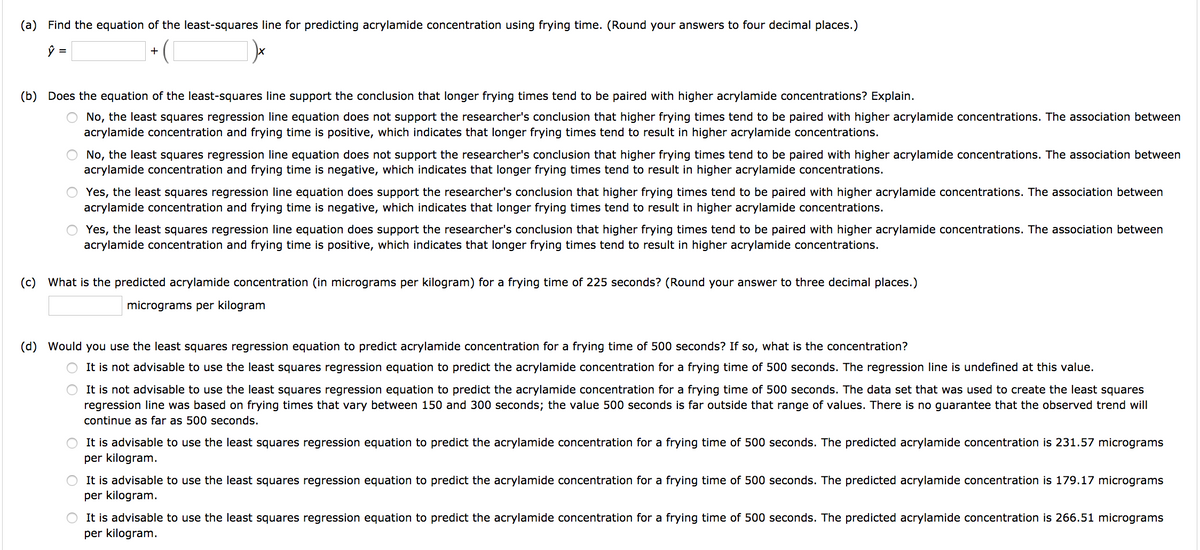(a) Find the equation of the least-squares line for predicting acrylamide concentration using frying time. (Round your answers to four decimal places.) (b) Does the equation of the least-squares line support the conclusion that longer frying times tend to be paired with higher acrylamide concentrations? Explain. O No, the least squares regression line equation does not support the researcher's conclusion that higher frying times tend to be paired with higher acrylamide concentrations. The association between acrylamide concentration and frying time is positive, which indicates that longer frying times tend to result in higher acrylamide concentrations. O No, the least squares regression line equation does not support the researcher's conclusion that higher frying times tend to be paired with higher acrylamide concentrations. The association between acrylamide concentration and frying time is negative, which indicates that longer frying times tend to result in higher acrylamide concentrations. O Yes, the least squares regression line equation does support the researcher's conclusion that higher frying times tend to be paired with higher acrylamide concentrations. The association between acrylamide concentration and frying time is negative, which indicates that longer frying times tend to result in higher acrylamide concentrations. O Yes, the least squares regression line equation does support the researcher's conclusion that higher frying times tend to be paired with higher acrylamide concentrations. The association between acrylamide concentration and frying time is positive, which indicates that longer frying times tend to result in higher acrylamide concentrations. (c) What is the predicted acrylamide concentration (in micrograms per kilogram) for a frying time of 225 seconds? (Round your answer to three decimal places.) micrograms per kilogram (d) Would you use the least squares regression equation to predict acrylamide concentration for a frying time of 500 seconds? If so, what is the concentration? It is not advisable to use the least squares regression equation to predict the acrylamide concentration for a frying time of 500 seconds. The regression line is undefined at this value. It is not advisable to use the least squares regression equation to predict the acrylamide concentration for a frying time of 500 seconds. The data set that was used to create the least squares regression line was based on frying times that vary between 150 and 300 seconds; the value 500 seconds is far outside that range of values. There is no guarantee that the observed trend will continue as far as 500 seconds. It is advisable to use the least squares regression equation to predict the acrylamide concentration for a frying time of 500 seconds. The predicted acrylamide concentration is 231.57 micrograms per kilogram. O It is advisable to use the least squares regression equation to predict the acrylamide concentration for a frying time of 500 seconds. The predicted acrylamide concentration is 179.17 micrograms per kilogram. O It is advisable to use the least squares regression equation to predict the acrylamide concentration for a frying time of 500 seconds. The predicted acrylamide concentration is 266.51 micrograms per kilogram.
Correlation
Correlation defines a relationship between two independent variables. It tells the degree to which variables move in relation to each other. When two sets of data are related to each other, there is a correlation between them.
Linear Correlation
A correlation is used to determine the relationships between numerical and categorical variables. In other words, it is an indicator of how things are connected to one another. The correlation analysis is the study of how variables are related.
Regression Analysis
Regression analysis is a statistical method in which it estimates the relationship between a dependent variable and one or more independent variable. In simple terms dependent variable is called as outcome variable and independent variable is called as predictors. Regression analysis is one of the methods to find the trends in data. The independent variable used in Regression analysis is named Predictor variable. It offers data of an associated dependent variable regarding a particular outcome.


Trending now
This is a popular solution!
Step by step
Solved in 2 steps with 3 images








